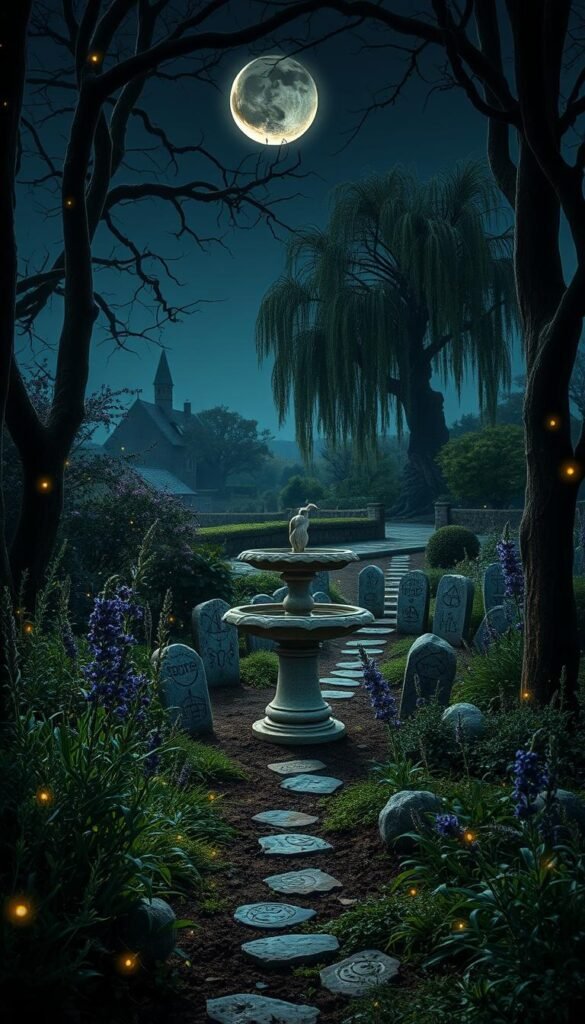Your outdoor space can become more than just a plot of land—it can channel centuries of tradition while reflecting your unique connection to nature. Imagine stepping into a sanctuary where every plant tells a story, and moonlight transforms ordinary paths into portals of wonder. This blend of practicality and magic lies at the heart of witch-inspired landscapes.
Long before modern gardening trends, people cultivated plants for both survival and symbolism. Many species now common in cottagecore gardening styles once held sacred roles in folk practices. Rosemary guarded homes, lavender promoted peace, and night-blooming flowers like evening primrose thrived under lunar cycles.
Today’s version of these spaces balances beauty with purpose. You’ll grow herbs for teas or remedies while designing corners that invite quiet reflection. Even small balconies can host potted mugwort or climbing moonflower vines, proving mystical charm doesn’t require acres of land.
As you explore this approach, you’ll discover how strategic plant choices attract pollinators and weave history into your daily life. Let’s uncover how to craft a living tapestry that honors earthy wisdom and whispers of enchantment with every breeze.
An Introduction to Witchy Garden Aesthetics
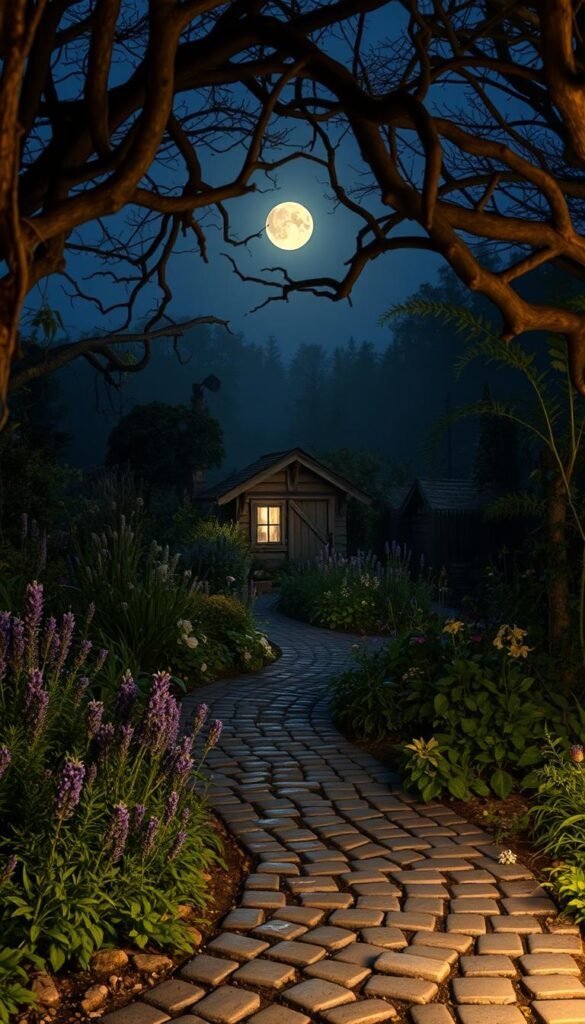
Transforming your space into a mystical retreat starts with understanding its deeper roots. These landscapes aren’t just about appearances—they’re living bridges between earthly knowledge and the unseen world. Whether you’re drawn to herbal lore or moonlit pathways, your choices reflect a dialogue with generations past.
Understanding the Magic Behind Your Garden
Every plant in your space holds layers of meaning. Mugwort might guide dreams, while thyme could whisper tales of courage from medieval kitchens. These green companions become partners in storytelling, their leaves holding more than chlorophyll.
Historical caretakers saw gardens as classrooms. They studied how yarrow staunched wounds and how chamomile softened tempers. Your plot continues this legacy when you choose species with purposeful histories.
Historical and Folklore Influences
Three threads weave through witchy garden traditions:
- European herbwives’ medicinal plots
- Indigenous American relationships with sacred plants
- Mediterranean temple gardens dedicated to deities
Modern designs blend these approaches. You might grow echinacea like Plains tribes did, then pair it with Roman-bred bay laurel. This fusion creates spaces where time collapses, and every blossom nods to multiple cultural truths.
Your corner of soil becomes a crossroads. Here, practical sage brushes against love-drawing roses, proving magic and utility have always grown side by side.
Designing Your Moon Garden: Embracing Twilight and Fragrance
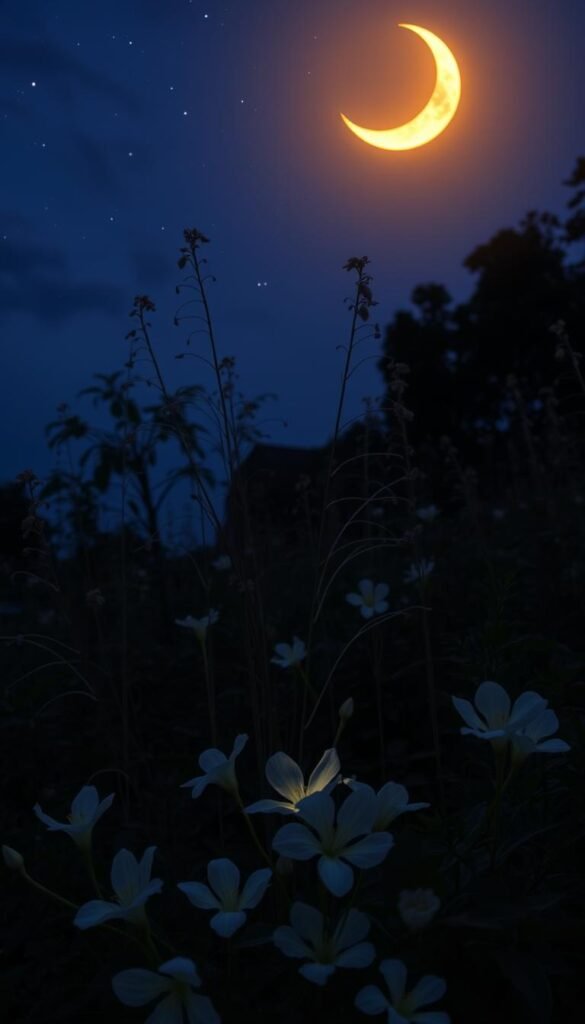
As daylight fades, your garden transforms into a silvery stage where blossoms perform under celestial spotlights. These spaces thrive when shadows lengthen, offering fragrant performances that dance with fireflies and moths. Timing matters—plant selections should peak during summer evenings when warm air carries scents farthest.
Selecting Night-Blooming Flowers
Prioritize plants with extended bloom times and intense aromas. Brugmansia steals the show with foot-long blossoms that perfume entire yards. Each flower acts like a natural diffuser, releasing sweetness that intensifies after sunset.
Datura offers fleeting beauty—its trumpet-shaped blooms unfurl at dusk and collapse by dawn. This nightly cycle creates dynamic textures under moonlight. Pair these showstoppers with:
| Plant | Bloom Time | Scent Profile | Height |
|---|---|---|---|
| Four O’Clocks | 4 PM – Morning | Spicy-sweet | 2-3 ft |
| Evening Primrose | Twilight – Sunrise | Lemon-honey | 1-2 ft |
| Night Phlox | Moonrise – Midnight | Vanilla-honey | 6-12 in |
Enhancing Scent and Sensory Experience
Layer fragrances like musical notes—place heavier scents (jasmine) near seating areas and lighter ones (primrose) along pathways. Warm stones radiate daytime heat, amplifying aromatic molecules after dark.
Position benches where breezes flow through scent corridors. A north-facing seat might catch gardenia whispers, while southern exposures carry tuberose’s bold perfume. Add wind chimes to amplify nature’s nightly symphony.
Incorporating Traditional Witch’s Garden Elements
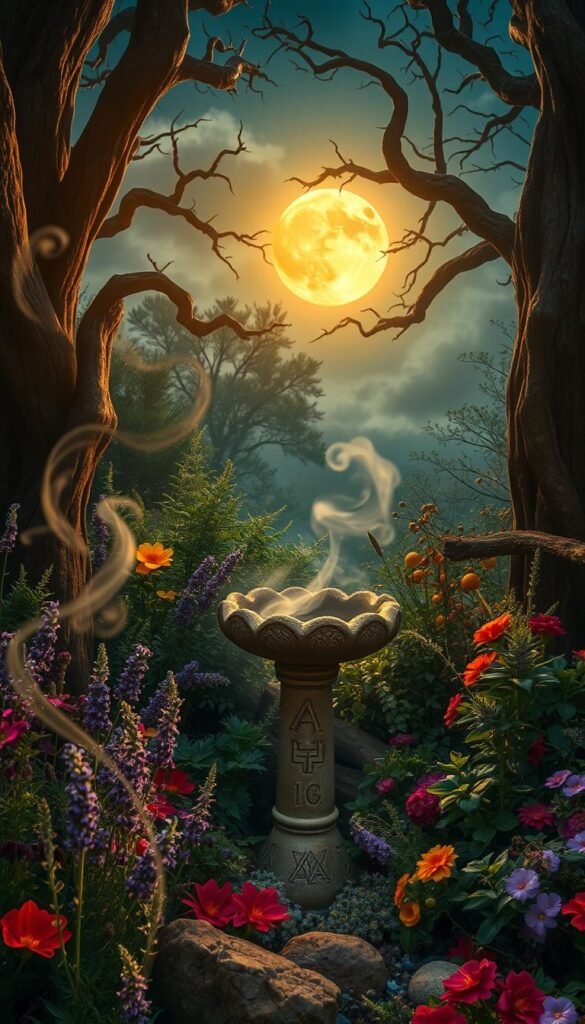
Every leaf and petal in your garden holds whispers of ancient tales. These spaces thrive when plants become storytellers, their roots tangled with centuries of human experience. You’re not just arranging greenery—you’re curating living symbols that bridge past and present.
Exploring Symbolism and Folklore in Garden Design
Your plant choices shape your garden’s hidden language. Foxglove, nicknamed “fairy thimbles” in folklore, showcases this duality. Its bell-shaped blooms charm cottage plots, yet its leaves contain digitalis—a heart medicine and poison. This balance of beauty and power defines witch-inspired designs.
Consider these symbolic pairings for intentional layouts:
| Plant | Symbolic Meaning | Magical Purpose | Placement Tip |
|---|---|---|---|
| Rowan | Protection | Wards off negative energy | Gateways or property edges |
| Mugwort | Divination | Enhances dream work | Moon-shaped beds |
| Hawthorn | Boundaries | Spiritual safeguarding | Perimeter hedges |
| Yarrow | Healing | Strengthens rituals | Near gathering spaces |
Folklore guides placement as much as species. Protective herbs like rosemary flourish near doorways, while moonflower vines climb arches to honor lunar cycles. Your layout might mirror celestial patterns—a circular bed for sun energy or starlike clusters of nightshade.
Even common plants gain new meaning. Lavender isn’t just fragrant—it’s a peace-bringer historically tucked into pillowcases. By blending these traditions, your space becomes a tapestry of earthly wisdom, where functionality and mystery share the soil.
Creating a Witchy Garden Aesthetic: Herbs, Moonlight, and Mystical Details
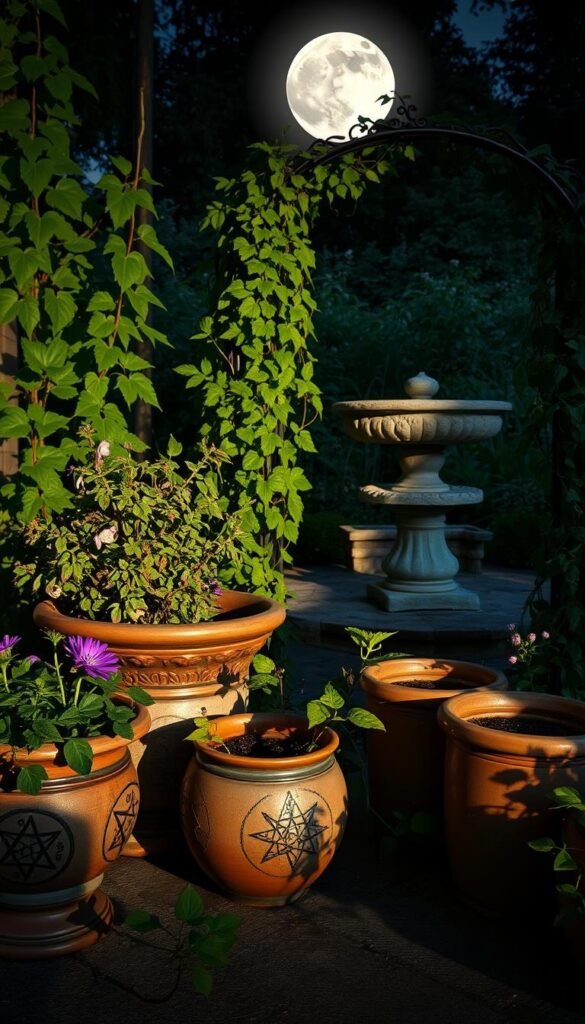
Twilight transforms even the coziest corners into realms where magic feels tangible. Small plots thrive when designed with intention—every potted herb and bloom becomes a star player under the moon’s glow. Container-grown Datura proves this, its intoxicating scent enveloping you completely when placed near seating areas.
Strategic placement amplifies energy. Position potted herbs where their fragrances mingle with night air—rosemary by windowsills, lavender beside pathways. Mirrors multiply silvery foliage’s glow, while crystals catch starlight like tiny beacons.
Your garden’s soul lives in details. Wind chimes tuned to gentle notes partner with rustling ornamental grasses. Moon-shaped stone arrangements guide footsteps, echoing celestial patterns underfoot. These touches require minimal space but create outsized atmosphere.
Balance defines the witch’s plot. Thorny roses guard healing chamomile beds—light and shadow coexisting. This duality thrives in compact layouts where every element serves dual purposes: beauty and protection, fragrance and folklore.
Complete your sanctuary with symbolic decor that whispers your unique story. A weathered cauldron overflows with ivy, while a crescent-shaped planter cradles protective sage. Here, practicality and mystery root deeply, proving enchantment needs no acreage—just vision.
Selecting and Caring for Magical Herbs
The true power of your enchanted space lies in its living ingredients—herbs that bridge the physical and spiritual realms. These green allies offer more than fragrance; they carry centuries of wisdom in their leaves and roots.
Botanical Partners With Purpose
Your herb selection shapes your garden’s energy. Consider these versatile options:
| Herb | Magical Use | Growing Zone |
|---|---|---|
| Rosemary | Love rituals, memory enhancement | 7-10 |
| Lemon Verbena | Purification, dream work | 8-11 |
| Vervain | Creativity boost, protection | 5-9 |
Thyme makes an excellent border plant, its tiny leaves whispering protection against nightmares. For kitchen magic, basil thrives in sunny spots while repelling negative energy.
Nurturing Your Green Allies
Most magical herbs demand well-draining soil—mix sand into clay earth for Mediterranean varieties. Harvest lavender just as buds open for peak aromatic potency. Morning dew enhances their spiritual properties when collected at dawn.
Companion planting boosts growth and symbolism. Try these pairs:
- Sage with cabbage (wisdom + abundance)
- Mint near roses (prosperity + love)
- Garlic bordering chamomile (protection + peace)
For year-round indoor herb gardens, propagate rosemary cuttings in water before transferring to pots. This maintains your connection to nature’s cycles, even in urban spaces.
Container Gardening for Small Spaces and Flexibility
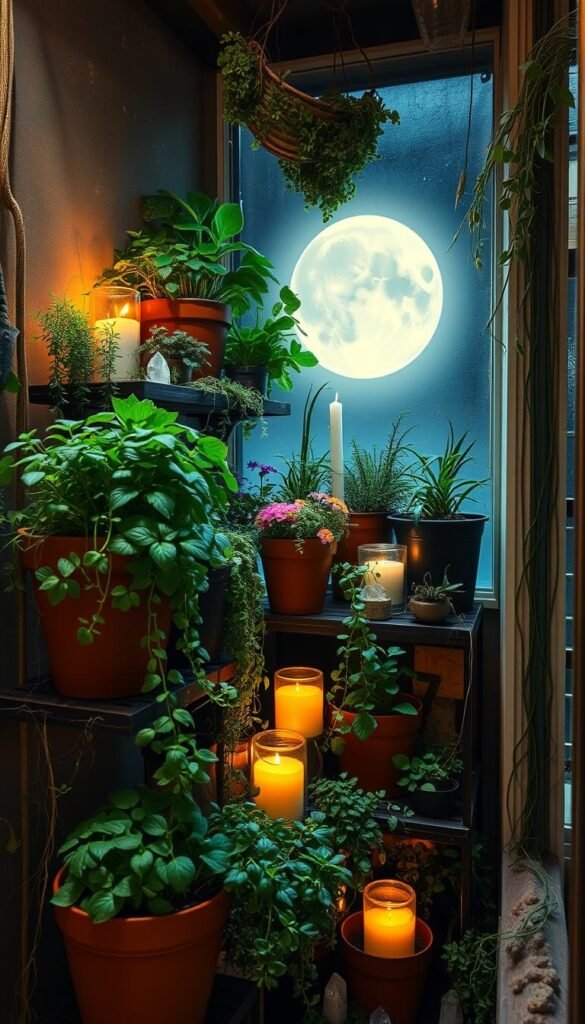
Your enchanted green sanctuary doesn’t need vast acreage—containers let you rearrange nature’s puzzle pieces with the seasons. In Zone 6A, where winters freeze roots and summers burst with life, pots become lifelines for tender plants. Tropical favorites like Brugmansia thrive outdoors until frost whispers through the air, then slip into basement dormancy like bears hibernating.
Choosing the right vessel matters. Oversized ceramic pots insulate roots but test your strength during seasonal moves. Consider these options:
| Container Type | Best For | Mobility |
|---|---|---|
| Fabric Grow Bags | Root-sensitive plants | Lightweight |
| Resin Planters | Long-term growth | Moderate weight |
| Terracotta Pots | Mediterranean herbs | Heavy |
Overwintering strategies split into two paths. Some species prefer dark naps in cool corners—water them monthly to prevent shriveling. Others demand sunny windowsills and weekly misting to combat dry indoor air. Your colorful container flowers might need grow lights if your house lacks south-facing exposure.
Small spaces amplify magic. A clustered trio of pots on a balcony creates an intimate circle for moonlit rituals. Their concentrated energy lets you notice subtle changes—new buds on rosemary stems or silvervine’s evening perfume. Just ensure drainage holes prevent soggy soil tragedies during spring rains.
Year-round care becomes a sacred rhythm. Summer means daily watering checks. Fall calls for gradual light reduction to prep plants for indoor life. Winter demands vigilance against spider mites, while spring invites pruning and fresh soil mixes. Each phase deepens your bond with these living talismans.
Enh
Your green haven grows richer with each season, becoming a mirror of your journey. Soil-stained hands and moonlit moments weave personal meaning into every corner. This isn’t just gardening—it’s cultivating relationships with roots and rituals.
Light plays its part naturally. Silver-leafed plants like lamb’s ear glow during dusk, while solar lanterns cast soft patterns on winding paths. These touches honor natural cycles without overpowering the night’s quiet magic.
Remember: intention fuels transformation. A single pot of basil on a fire escape can channel purpose as powerfully as sprawling beds. What matters is how you engage—harvesting mint for tea becomes a meditation, pruning roses turns into boundary-setting.
Share your space’s stories. Host friends for sunset gatherings where jasmine’s perfume mingles with laughter. Let children taste edible flowers, connecting them to earth’s sweetness. These interactions deepen your plot’s role as a living classroom.
As stars emerge, your sanctuary whispers back. Wind rustles through sage, carrying wishes planted months ago. Here, practicality and wonder share soil—proof that magic thrives where we nurture it.

